Most good walleye anglers get real excited when the first
good ice of the year appears. The fish are aggressive and
still willing to swim a fair distance for something to munch
on. As a result, it pays to be aggressive in your tactics
to catch them. New rattling spoons and advances in lure
design will allow you to be even more successful than traditional
methods.
For example, the Rattlin’ Flyer Spoon offers the fish
a vertical presentation, holographic flash and sound plus
the ability to “cast” under the ice that’s
deadly when walleyes are nearby.
Another new aggressive vertical jigging lure that is now
available is the Lindy Darter. This bait can be pumped aggressively,
has an irresistible, life-like action plus brass rattles
which bring fish in.
Other baits can be effective, but they often peak in performance
during the golden hours around sunrise and sunset. While
these low-light periods are still the best times to have
a lure in the water, aggressive tactics will help you catch
walleyes all day long.
Location
Finding the best location is the key to catching fish. While
there is no such thing as a magic lure that will catch fish
all the time and everywhere, you must drill holes in their
neighborhood.
In natural lakes, first ice will find walleyes near the
steepest breaks on shoreline structure. Study a hydrographic
map and look for the fastest drop-off to the deepest part
of the lake. Humps and points are good spots as well.
Early ice is often the time to visit those shallow prairie
lakes that were too weedy to fish effectively in summer.
Focus on hard-bottomed spots like rock piles and even small
structural features. A slight rise or hard spot on the bottom
can be holding areas for walleyes.

A dandy early-ice walleye falls prey to aggressive
jigging of a Lindy Darter. Follow the formula outlined
by walleye pro Ted Takasaki, and you’ll be holding
up fish like this on your next outing |
Stick with shoreline structure on bigger
lakes like Mille Lacs or Lake of the Woods. Check out
spots where reed beds stick up through the ice. The
edge of the reed beds will hold walleyes.
As always, points are the prime real estate in reservoirs,
but look for the ones with the sharpest breaks into
the old channel, which will be the deepest water in
the system.
Gear
It is best to use an ice rod that is fairly stout with
a stiffer tip, like St. Croix’s Legend Ice - LIR24M.
If the rod is too limber, you can move and jiggle it
all day long and little of the action will be transferred
to the bait. You must be able to shake a Rattlin’
Flyer Spoon or Darter hard enough to get them to make
some noise and work well. Remember that whatever the
rod tip is doing, the lure is doing below. |
Start by using low-stretch mono in 6- to 8-pound-test.
If you’re fishing deeper water, try using a super
braided line, like Power Pro, to increase your sense of
touch–detect bites, feel bottom, and transfer action
to the lure.
A hand-held GPS helps to locate spots you hopefully programmed
in during the open-water season, when moving around to scout
was much easier than after the ice formed.
A flasher or electronics is critical. Humminbird’s
new ICE 55 is awesome and easy to use. Sonar offers the
ability to detect walleyes that move close to your bait.
You can also watch the display color change as the fish
move ever closer. Gauge their mood and the action they want
by whether they continue to move to the center of the hole
and take the bait or veer off. Too many near misses are
an invitation to change jigging action or color.
Keep your color choices simple. In low-light periods, red
Techni-Glo works well because red glow is the brightest.
When you charge it with your Tazer (a small hi-intensity
flashlight which is designed to light up glow lures), fish
can see it the farthest away. At sunrise and sunset, they
will be attracted a long ways.
Blue glow lasts the longest, so it’s a good night
color when bigger fish are more apt to bite. Effective daytime
colors vary according to water color and walleye preference.
Chartreuse is always a good choice, but play with the greens,
the oranges and the yellows. Keep adjusting the color to
what the fish are telling you.
By using and understanding your electronics, you can tell
when fish are coming by and not biting. If that happens,
make color changes, adjust your jigging motion, or change
lures entirely. An underwater camera can help if you aren’t
moving around a lot.
Fishing a Spoon
The design of the Rattlin’ Flyer Spoon mimics its
predecessor, the Flyer Jig. They glide when they are dropped
down the hole, allowing ice anglers to cast a 6-foot radius
around their hole. What you do next is critical.
Don’t just lift it and let it ‘pendulum’
back below the hole. Slowly drag and twitch the spoon as
you bring it back. You’re “casting” almost
fishing like you would in open water, thus covering more
fishing areas from one spot.
Walleyes often inhale it right from the bottom. But if not,
the next step is to pound it into the bottom over and over.
It puts the “poof” factor on your side. There’s
always sediment on the bottom. When you lower the bait to
the bottom and shake it or pound it, it will cause the sediment
to mushroom up. It looks like fish feeding on bloodworms
and larvae. It can cause a feeding frenzy of perch and then
the bigger fish come in to feed on the perch.
The last step is to lift the lure off the bottom and jig
the bait aggressively to make the rattles work for you.
It’s like a dinner bell for a curious walleye. A major
mistake many anglers make is to lessen the intensity of
their jigging when a walleye shows up on the flasher.
When a fish shows up, don’t freeze up! Keep jigging
aggressively to keep the rattles working. If fish turn away,
then try modifying your jigging action.
So, the lesson is: first drag, then pound, and then jig
the spoon.
If you like fishing with live bait on a bobber, that’s
not a problem. Just leave one hole for aggressive jigging.
There will be times when you’ll be jigging and get
nothing, then quit a moment and the bobber next to you goes
down. It’s not hard to figure out what happened. You
called the fish in with the rattles, but maybe it wanted
sometime more neutral looking so it turned off and took
the minnow on the ‘dead stick’ or tip-up instead.
If aggressive jigging doesn’t do the trick, try switching
to a Genz Worm or a Fat Boy dressed with several colored
maggots, or ‘spikes’ as they’re also called.
Poof the bottom with them, too, pounding the jig to send
sediment into the water to attract perch and walleyes.
|



